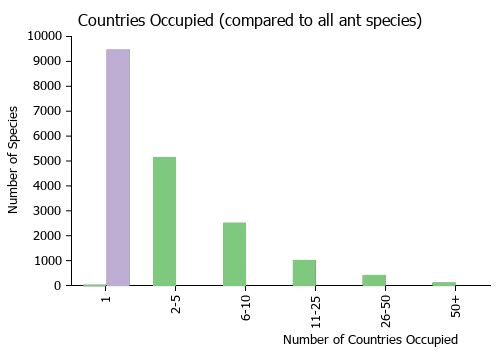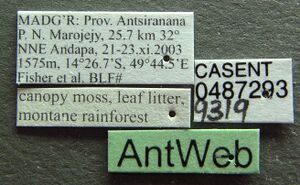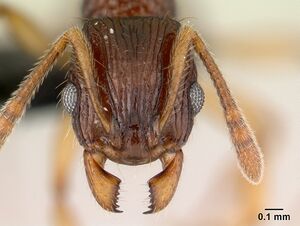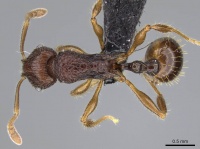Vitsika manifesta
| Vitsika manifesta | |
|---|---|

| |
| Scientific classification | |
| Kingdom: | Animalia |
| Phylum: | Arthropoda |
| Class: | Insecta |
| Order: | Hymenoptera |
| Family: | Formicidae |
| Subfamily: | Myrmicinae |
| Tribe: | Crematogastrini |
| Genus: | Vitsika |
| Species: | V. manifesta |
| Binomial name | |
| Vitsika manifesta Bolton & Fisher, 2014 | |
All material of manifesta is from montane shrubland and rainforest, at considerable altitude (1565–2000 m.). Specimens have been retrieved from litter samples and yellow pan traps.
Identification
Bolton and Fisher (2014) - As seen in posterior view, the high, narrow petiole node, whose dorsal margin rises to a narrowly rounded median peak, is immediately diagnostic of manifesta. The height of the node in posterior view (from midpoint of the dorsal margin of the foramen to the highest point of the node) is 1.10–1.23 × its maximum width; i.e. the node is always higher than wide. In all other species of Vitsika, with the node in posterior view the dorsal margin is always flat to broadly, shallowly convex (concave in Vitsika incisura). In the remainder of the genus the total range of height of node is 0.66–1.10 × its maximum width. Only Vitsika labes has an upper value of 1.10, but here the postpetiole node in profile is distinctly longer than the height of the segment.
Keys including this Species
Distribution
Endemic to Madagascar.
Latitudinal Distribution Pattern
Latitudinal Range: -14.43527778° to -14.43527778°.
| North Temperate |
North Subtropical |
Tropical | South Subtropical |
South Temperate |
- Source: AntMaps
Distribution based on Regional Taxon Lists
Malagasy Region: Madagascar (type locality).
Distribution based on AntMaps
Distribution based on AntWeb specimens
Check data from AntWeb
Countries Occupied
| Number of countries occupied by this species based on AntWiki Regional Taxon Lists. In general, fewer countries occupied indicates a narrower range, while more countries indicates a more widespread species. |

|
Estimated Abundance
| Relative abundance based on number of AntMaps records per species (this species within the purple bar). Fewer records (to the left) indicates a less abundant/encountered species while more records (to the right) indicates more abundant/encountered species. |

|
Biology
Castes
Males have yet to be collected.
Worker
Images from AntWeb
   
| |
| Worker. Specimen code casent0487293. Photographer Michele Esposito, uploaded by California Academy of Sciences. | Owned by CAS, San Francisco, CA, USA. |
   
| |
| Worker. Specimen code casent0487393. Photographer Erin Prado, uploaded by California Academy of Sciences. | Owned by CAS, San Francisco, CA, USA. |
Queen
Images from AntWeb
   
| |
| Queen (ergatoid). Specimen code casent0914198. Photographer Michele Esposito, uploaded by California Academy of Sciences. | Owned by CAS, San Francisco, CA, USA. |
   
| |
| Queen (ergatoid). Specimen code casent0914197. Photographer Michele Esposito, uploaded by California Academy of Sciences. | Owned by CAS, San Francisco, CA, USA. |
Nomenclature
The following information is derived from Barry Bolton's Online Catalogue of the Ants of the World.
- manifesta. Vitsika manifesta Bolton & Fisher, 2014: 84, figs. 102-104, Map 156 (w.q.) MADAGASCAR.
Unless otherwise noted the text for the remainder of this section is reported from the publication that includes the original description.
Description
Worker
(holotype in parentheses). TL 3.3–4.1 (4.0), HL 0.72–0.90 (0.84), HW 0.62–0.76 (0.72), CI 83–88 (86), SL 0.56–0.68 (0.62), SI 80–90 (86), PW 0.48–0.62 (0.58), WL 0.92–1.18 (1.04) (15 measured).
Eye with 5–8 rows of ommatidia, and with 6–10 ommatidia in the longest row; EL 0.15–0.20 (EL/HW 0.23–0.28). MfL 0.68–0.88 (MfL/HW 1.21–1.32). Oblique costulae on mesopleuron conspicuous. Diameter of annulus of propodeal spiracle is usually slightly greater than the thickness of the propodeal spine at its midlength. Propodeal declivity transversely costulate. In posterior view the petiole node tall and slender, its dorsal margin rising to a narrowly rounded median peak. Height of petiole node in posterior view (from midpoint of the dorsal margin of the foramen to the highest point of the node) 1.10–1.23 × its maximum width. In dorsal view postpetiole 1.07–1.15 × broader than long; maximum width of postpetiole 1.00–1.10 × the length of a propodeal spine; maximum width of postpetiole 0.90–1.04 × the distance between the apices of the propodeal spines. Side of petiole node usually, but not always, with longitudinal costulae; when present the costulae tend to overlap onto the posterior surface of the node, at least posterolaterally. Length of postpetiole node less than the height of the segment. Disc of postpetiole mostly smooth, but longitudinal costulae are usually visible laterodorsally. Full adult colour rich reddish brown to dark brown.
Queen
(gyne). Ergatoid, alate, and intermediate (e.g. CASENT0914198) forms are known. Ergatoid: HL 0.86, HW 0.75, CI 87, SL 0.64, SI 85, PW 0.55, WL 1.12, MfL 0.84. The ergatoid has three ocelli. The mesosoma is almost worker-like except that the mesonotum is slightly enlarged compared to the worker. The mesopleural sulcus is absent. Intermediate: HL 0.84, HW 0.74, CI 88, SL 0.60, SI 81, PW 0.56, maximum length of mesoscutum 0.40, maximum width of mesoscutum 0.40, WL 1.08, MfL 0.78. Three ocelli present. Mesosoma with a full complement of flight sclerites, but the individual sclerites small, considerably reduced from size seen in alate queen, and without trace of wing articulations. Mesopleuron with a transverse sulcus. Alate: HL 0.87, HW 0.79, CI 91, SL 0.64, SI 81, PW 0.68, maximum length of mesoscutum 0.70, maximum width of mesoscutum 0.68, WL 1.30, MfL 0.86. Three ocelli present. Mesosoma with a full complement of full-sized flight sclerites, with wing articulation present. Mesopleuron with a broad transverse sulcus. Note that in all forms most measurements are within the worker range, but in the fully alate form PW and WL are greatly increased. Also, the mesoscutum is much larger in the alate than in the intermediate.
Type Material
Holotype worker, Madagascar: Prov. Antsiranana, P.N. Marojejy, 25.7 km. 32° NNE Andapa, 21–23.xi.2003, 1575 m., 14°26.7’S, 49°44.5’E, sifted litter, montane rainforest, BLF 9242(9), CASENT0040789 (Fisher et al.) (California Academy of Sciences). Paratypes. 7 workers with same data as holotype, and all BLF 9242; (L0) CASENT0040797, (4) CASENT0040784, (6) CASENT0040790, (10) CASENT0040791, (13) CASENT0040792, (16) CASENT0040793, (22) CASENT0040795 (CASC, The Natural History Museum).
References
- Bolton, B. & Fisher, B.L. 2014. The Madagascan endemic myrmicine ants related to Eutetramorium (Hymenoptera: Formicidae): taxonomy of the genera Eutetramorium Emery, Malagidris nom. n., Myrmisaraka gen. n., Royidris gen. n., and Vitsika gen. n. Zootaxa 3791:1–99. doi:[http://dx.doi.org/10.11646/zootaxa.3791.1.1 10.11646/zootaxa.3791

